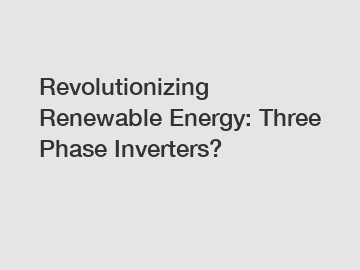Feb. 19, 2024
Energy
Renewable energy has become a driving force in the efforts to combat climate change and transition towards a more sustainable future. Solar and wind energy in particular have grown in popularity as sources of clean, renewable power. In order to harness the potential of these resources, efficient and reliable inverters are necessary to convert the direct current (DC) produced by solar panels or wind turbines into alternating current (AC) that can be used to power homes and businesses. Three-phase inverters are leading the charge in revolutionizing renewable energy by providing greater efficiency, reliability, and flexibility for renewable energy systems.
Three-phase inverters have become the preferred choice for solar and wind energy systems due to their ability to convert DC power into AC power with greater efficiency than single-phase inverters. By utilizing three separate phases, three-phase inverters can distribute the power more evenly across the electrical system, resulting in a more stable and reliable output. This increased efficiency not only maximizes the power output of the renewable energy system, but also reduces energy losses during the conversion process, ultimately saving money and resources in the long run.
In addition to efficiency, three-phase inverters offer greater reliability and flexibility compared to single-phase inverters. The three-phase design allows for better balancing of the electrical load, which can help prevent voltage fluctuations and power surges that can damage sensitive equipment. This increased stability is crucial for ensuring the continuous and uninterrupted operation of renewable energy systems, particularly in regions with inconsistent grid conditions or a high demand for energy.

Furthermore, three-phase inverters are also more flexible in terms of installation and scalability. They can easily accommodate larger capacity systems and can be connected to multiple solar panels or wind turbines, allowing for greater customization and optimization of the renewable energy system. This scalability is especially important for commercial and industrial applications where energy demands are higher and more complex, requiring a versatile inverter solution that can adapt to changing needs.
One of the key advantages of three-phase inverters is their ability to provide grid support and enhanced grid integration. As renewable energy systems become more prevalent, the need for seamless integration with the existing electrical grid becomes essential. Three-phase inverters are equipped with advanced grid support features such as reactive power control, voltage regulation, and frequency response capabilities, which help stabilize the grid and improve overall system reliability. This grid-friendly technology enables renewable energy systems to operate more efficiently and effectively, while also contributing to the stability and resilience of the grid as a whole.
In conclusion, three-phase inverters are revolutionizing renewable energy by offering greater efficiency, reliability, and flexibility for solar and wind energy systems. Their ability to convert DC power into AC power with higher efficiency, provide grid support and enhanced grid integration, and offer scalability and customization make them the ideal choice for powering sustainable energy solutions. As the demand for clean and renewable energy continues to grow, three-phase inverters will play a crucial role in shaping the future of energy generation and distribution. By harnessing the power of three-phase inverters, we can accelerate the transition towards a more sustainable and environmentally friendly energy landscape, paving the way for a cleaner and brighter future for generations to come.
For more pv inverter manufacturers, 3 phase inverter vs single phase inverter, how to connect 3 phase solar inverterinformation, please contact us. We will provide professional answers.
If you are interested in sending in a Guest Blogger Submission,welcome to write for us!
All Comments ( 0 )